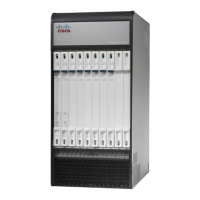2
The associated minicore, NPU or kernel dump file is stored in the /flash/crsh2 directory.
3
A full core dump is stored in a user configured directory.
The crashlog2 file along with associated minicore, NPU and kernel dumps are automatically synchronized
across redundant management cards (SMC, MIO/UMIO). Full core dumps are not synchronized across
management cards.
Important
The following behaviors apply to the crash logging process.
•
When a crash event arrives on an active management card, the event record is stored in its crashlog2
file along with the minicore, NPU, or kernel dump file in /flash/crsh2. The crash event and dump file
are also automatically stored in the same locations on the standby management card.
•
When a crash log entry is deleted via CLI command, it is deleted on both the active and standby
management cards.
•
When a management card is added or replaced, active and standby cards will automatically synchronize
crash logs and dump files.
•
When a crash event is received and the crash log file is full, the oldest entry in the crash log and its
related dump file will be replaced with the latest arrived event and dump file on both management cards.
Information for a maximum of 120 crash events can be stored on management cards.
•
Duplicate crash events bump the count of hits in the existing record and update the new record with the
old crash record. Additions to the count use the timestamp for the first time the event happened.
Configuring Software Crash Log Destinations
The system can be configured to store software crash log information to any of the following locations:
•
On the ASR 5500:
◦
Flash memory: Installed on the active MIO/UMIO [abridged crash log and associated dump files
only]
◦
USB memory stick: Installed in the USB slot on the active MIO/UMIO
•
On VPC
◦
Flash memory: Accessible by the virtual machine
◦
USB memory stick: Installed in the USB slot of the platform (USB slot has been enabled via the
hypervisor)
•
Network Server: Any workstation or server on the network that the system can access using the Trivial
File Transfer Protocol (TFTP), the File Transfer Protocol (FTP), the Secure File Transfer Protocol
(SFTP), or the Hyper-Text Transfer Protocol (HTTP); this is recommended for large network deployments
in which multiple systems require the same configuration
In release 20.0 and higher Trusted StarOS builds, FTP is not supported.Important
ASR 5500 System Administration Guide, StarOS Release 21.5
144
System Logs
Configuring Software Crash Log Destinations

